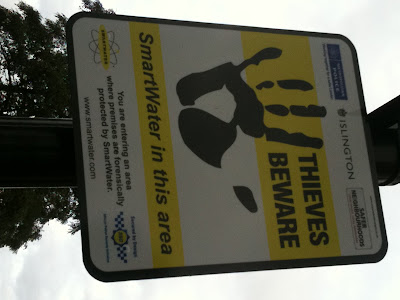The militarization of the urban arena that
can be witnessed especially across the developed world renders the city an ever
more hostile location for its citizens.
Many articles have been written recently on
the topic of military urbanism and I would like to share some of my collected
bookmarks especially in relation to new surveillance techniques herewith to
illustrate the vast and multifaceted contemporary phenomenon.
The thematic has gained topicality
especially in London in anticipation of the 2012 Olympics. Unmanned
drones equipped with surveillance cameras will patrol
over London during the Olympic games. Quiet Babylon notes that it has been
a ‘bounteous
season for panoptiswarm-related news’. Now everybody gets a drone: from Occupiers
(details here)
to journalists. One has to live
with urban drones these days. Find here
a video discussion on the impact of domestic drones on privacy, safety and
national security. The event was organised in reaction to a new aviation bill
in the US that has been signed in February and which will open domestik skies
to ‘unmanned aircraft systems’.
 |
| Facewatch ID app (source) |
Apart from surveillance drones another measure
is Scotland Yard’s free ‘wanted’ app which is called Facewath ID. The app will allow people to
see CCTV images of suspects in their area by using their smartphone’s location
services.
 |
| Smart Water campaign (source) |
 |
| Smart Water areas (Image by author) |
Various examples of new technologies of
surveillance evoke an even gloomier
image of a militarised city. Intelligent
geotextiles or Smart
Dust are still under development but can be imagined to be a substantial
part of our future cities’ surveillance systems. Smart Dust will be ‘comprised
of speckle-sized devices that can sense environmental conditions, such as
light, temperature and humidity. More importantly, they can gather civilian and
military intelligence. Their tiny dimensions mean they are difficult to detect and can squeeze through the narrowest of gaps in doors and walls. They can communicate with each other wirelessly, as well as transmit data to a nearby command center or remote satellite’.
 |
| Cybugs (source) |
To finish this list of links I would like
to point to an artwork dealing with these topics: Recent research and
developments in pollen forensics (forensic palynology) have led the artist Thomas Twaites to think about the
possibility of bee – policing. In his vision, developed together with James
French, a PhD student at the UCL
Department of Security and Crime Science, he imagined private person’s
plants being monitored by the police through analysing the bees’ pollen. This
method can be used to identify genetic manipulated plants or growing of illegal
substances. In this case nature in form of an insect becomes a means of power.
Similarly to bomb
sniffing military bees, these insects can be easily utilised to spy on
urban citizens under the disguise of security and safety.
Header Image source
Header Image source



0 comments:
Post a Comment